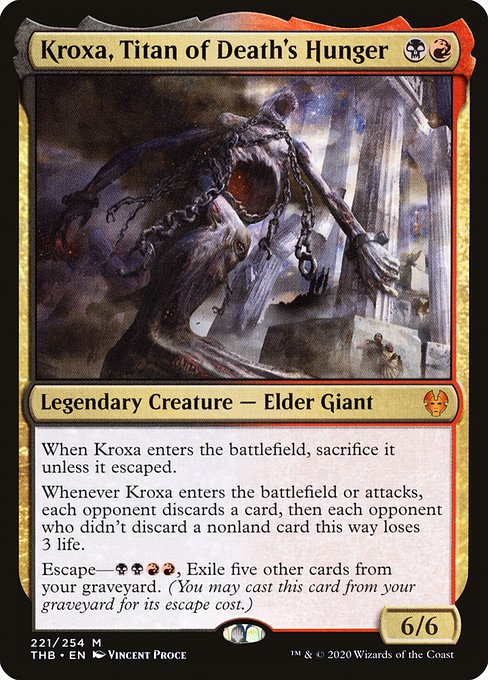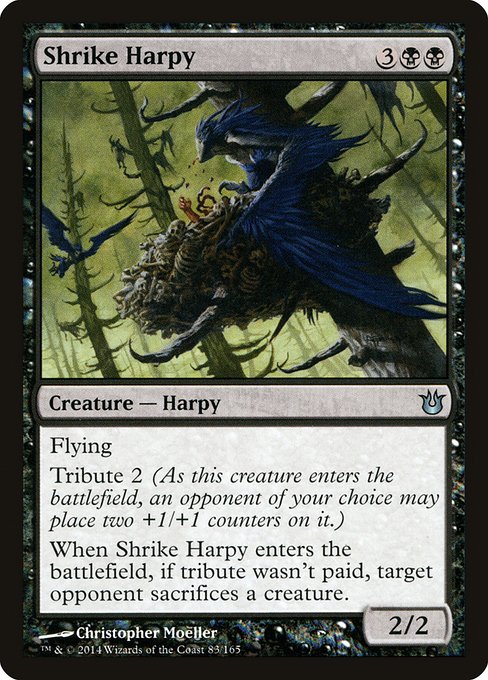Comics artist Nina Matsumoto (@spacecoyotl on Twitter) dropped a beautiful work of art that made me ponder, based off of Planters’ misguided “baby nut” ad campaign and Francisco Goya’s “Saturn Devouring His Son.” Saturn, or Cronus, was the Titan who ate his children at birth in order to (unsuccessfully) counteract a prophecy that one of them would go on to overthrow him; one of his children, Zeus, escaped his filiphagy and went on to castrate and kill Cronus. Theros offers Kroxa, Titan of Death’s Hunger, inspired by the Cronus myth; his ceaseless hunger mirrors that of the Titan of Greek myth.

As Americans, we haven’t grappled with food scarcity for some time. Food insecurity, certainly, but there’s abundance in sight, even if we can’t afford it or don’t know where to find it. That’s, appropriately enough to Theros, literally tantalizing—Tantalus, from whom we get “tantalize,” was punished for cooking his son and serving him to the gods by being tormented with endless thirst and hunger and with food and water that perpetually recedes just out of reach. Those of us who are luckiest know hunger, but we know it as a temporary state, not a constant. Kroxa’s brilliant design suggests that constancy, requiring periodic tributes from your opponent to sate their hunger, and we’re going to study it further.
Six power annd toughness is the Titan size, as enshrined by M11’s cycle of hyperpowerful mythics, so it’s not a surprise to see Kroxa at that threshold. What’s unique about Kroxa is the mana cost—dropping a 6/6 on turn two isn’t something that happens outside of Legacy in most cases. Of course, you’re going to sacrifice them immediately, barring Stifle or Trickbind; but being able to get power triggers (for example, Pandemonium or Warstorm Surge) off of two mana is intriguing. More synergistic still is Kroxa’s relationship with mana cost-based reanimation. You still have to sacrifice Kroxa if it doesn’t specifically Escape from the graveyard, but Reanimate in Legacy, Unearth in Modern, and Claim // Fame in Pioneer can let you double dip on that pseudo-Blightning.
That “pseudo-Blightning” is simple, but requires a couple of reads—the double negative of “who didn’t discard a nonland card this way” is a bit opaque. Basically, if they ditch a land or can’t discard a card at all, they lose 3 life. If they discard a nonland card, they don’t. Three damage is a Blightning, of course, but notably, it’s also the damage dealt by Famine, and it’s also the life gained by consuming a Food token. There’s a reason that Food tokens give you three life—it’s an appropriately small but relevant shot of life—and there’s a reason that “hunger” deals three damage: it’s a relevant but manageable punishment, at least at first.
Anyone who’s faced down a Kroxa in Limited can tell you that those small tributes add up awfully quickly. The first time is a nuisance, but if they escapes—and in my experience, they will be escaping—you’re forced to make a debilitating deliberation each turn. Magic is at its most interesting when there’s a layer of long-term resource management and lost opportunity, rather than a simple binary of “do I do this now or later,” and Kroxa makes the game revolve around that management matrix. Do I discard a land to feed the Titan and starve myself? Do I ditch Skola Grovedancer as nonrelevant, or do I play her and then start discarding lands for reduced damage? All of it is determined by how you want to pay Titanic tribute.

Tribute was a pretty maligned mechanic—for good reason. Any mechanic that gives your opponent control over the outcome will be inherently the worst deal for you, assuming competent analysis from your opponent. I wasn’t surprised to see it left out of Theros, except for a subtle callback in Kroxa, Titan of Death’s Hunger. Kroxa’s Titan ability forces a choice, and if you have no lands, you can’t choose to produce food to placate the titan. It’s an elegant story within a single card, and if Kroxa is able to attack a time or two, it feels like you’re a part of the story.
Speaking of story, Kroxa’s Escape ability comes from the Theros story—with the Underworld of Theros opened by a war between the gods, the Titans are able to escape the gaze of Klothys and return to their former domain. (Sidebar: Klothys appears to take her name and role from Clotho, one of the three Fates who spin mortal destiny.) Even if they’re able to be killed, the lack of security in the Underworld means they can always return. It’s unclear at the moment, due to the revision of the planned story release, whether the Underworld returns to its previous inaccessibility; so we don’t yet know if the Titans are permanently vanquished. I will say this, as someone who’s played against Kroxa: it takes a lot to get rid of Kroxa permanently. Eat to Extinction will work—ironic, but I suppose it can be read as Kroxa eating literally everything else before itself.
I’ve been in an apocalyptic mood for a variety of reasons recently, but mostly because we’re emerging from a spate of 70+ degree days (21 degrees in Celsius). All the trees started blooming in early February—the fleshy hibiscuses, the dogwoods, the pungent Bradford pears, all blossoming before Valentine’s Day. It’s pretty, but it’s a reminder that, if we freeze again this year, all the new peaches, all the delicate crops that we depend on economically and nutritionally, will die. Part of life in the era of disruptive climate change is a constant loss of security, a low-level anxiety that tells you the promise of abundance and access of the ’90’s is long gone. Like hunger, it’s constant and disruptive and only temporarily alleviated. We were promised the world when we were growing up—is it any wonder that we’re starving now?
A lifelong resident of the Carolinas and a graduate of the University of North Carolina, Rob has played Magic since he picked a Darkling Stalker up off the soccer field at summer camp. He works for nonprofits as an educational strategies developer and, in his off-hours, enjoys writing fiction, playing games, and exploring new beers.

